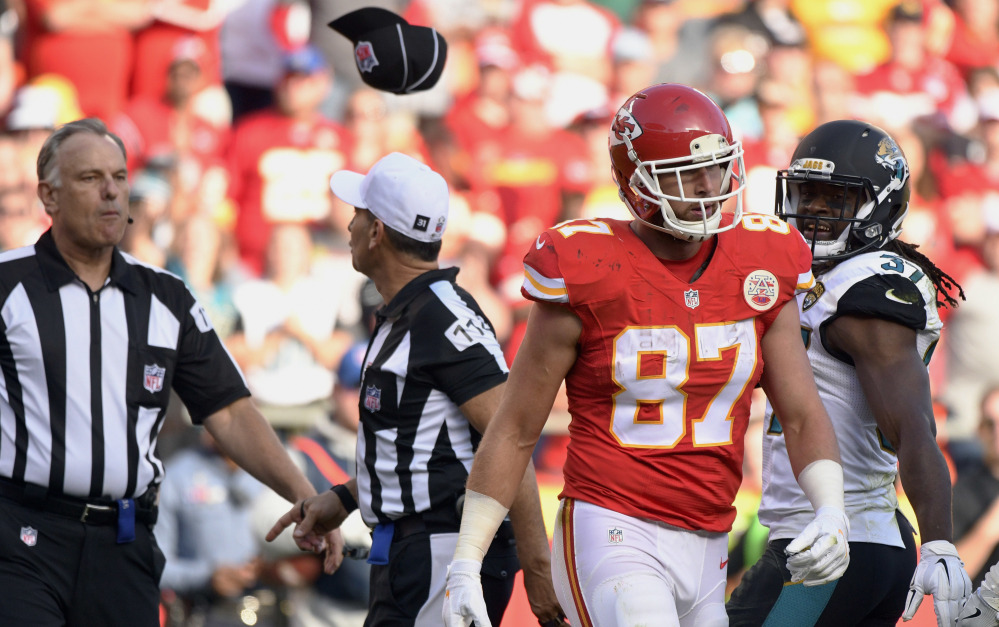This has been the year of the penalty in the NFL.
Not so much because more flags have been thrown in 2016 – through Week 15 teams were averaging 8.09 flags a game this season compared to 8.10 in 2015 – or because a larger-than-normal number of games have been decided by questionable calls.
More because the questioning of the competence of the officials began, literally, on opening day with a flurry of unflagged hits to the head of the reigning MVP, Cam Newton, and continued, in some form, virtually every week, without a stop.
Patterns? There weren’t any, in particular.
Phantom pass interference calls have been as common as unflagged hits to the head, the likes of which sent Newton to the commissioner’s office. There were petty calls for hugging refs (Earl Thomas) and throwing towels (Travis Kelce got ejected ), all underscored by a flurry of flags for celebrations that grew more subversive the harder the NFL tried to curb them.
Replay worked – sometimes. But it didn’t change anything at the end of the Cowboys-Vikings game. Cedric Thornton wasn’t flagged even though he clearly hit Minnesota quarterback Sam Bradford in the head as Bradford threw for a potential tying 2-point play.
Also not reviewed: The non-call for Richard Sherman’s takedown of Julio Jones at the end of the Seahawks-Falcons game; or a particularly poor spotting of the ball in an especially poorly called game between the Texans and Raiders.
“The scrutiny and the attention are at an all-time high on anything related to NFL, and that is a very positive thing,” said Dean Blandino, the NFL’s senior vice president of officiating.
What to do about all this?
Nothing new here – there is no single answer, but merely a list of remedies the NFL could consider in the offseason.
FULL-TIME REFEREES: The league is considering hiring 17 full-time officials and increasing the size of officiating crews from seven to eight. The part-time official has long been a staple of the league, and there’s good reason for it. Why would an official quit his day job for one with very little job security? Only if the league and the unions representing the players and officials can figure out a way to guarantee full-time officials some job security will this work out. Even then, 17 full-time referees will only represent a bit more than 10 percent of the workforce.
“Over 60 percent of (questions from coaches) are not about calls made but those not made,” Blandino said. “So we could cover more of the field of play, which of course is a positive.”
PASS INTERFERENCE: It’s an almost annual cry: The NFL should consider changing its long-held rule on penalizing pass interference at the spot of the foul in favor of the more lenient college rule, which calls for only a 15-yard penalty.
The con to this is that it would now pay for a badly beaten defensive back to dive and tackle a receiver who was breaking open for a sure touchdown.
TARGETING REPLAY: Week 14 was Exhibit A, but hardly the only example of an instance in which officials could have used help from the booth to determine whether to eject a player for targeting to the head.
Darren Sproles of the Eagles was moving forward to field a punt when Deshazor Everett of Washington launched himself into Sproles and hit him helmet to helmet, knocking Sproles out of the game.
In college, this play might’ve been sent to the booth to determine if the rule calling for an automatic ejection should be enforced. The NFL does none of that, and Mike Pereira, the former VP of officiating for the NFL, explained that the call wasn’t as automatic as many outraged posters on social media made it sound.
“Sproles didn’t call for a fair catch, and you’ve got a guy running toward him, trying to time the hit with the ball behind him and he can’t see it,” he said. That doesn’t always make it a play worthy of an ejection, Pereira explained, but rather a timing play that went awry.
SPOTTING THE BALL: The Nov. 21 game between the Raiders and Texans may have been the worst-called of the season.
Among the misses: a pair of questionable spots with the Texans trying to gain short yardage to keep a potentially go-ahead drive going. Replays indicated the officials may have missed the spots both times..
The league is looking into technology already used in soccer: inserting a chip into the football that would help officials make more accurate spots.
NO FUN LEAGUE: Penalties for celebration were up more than 50 percent from 2015 midway through the season. Blandino said for all the fuss, only 27 had been called through Week 15. But the league will review the rule in the offseason.
“The (competition) committee is really focused on not taking the spontaneous emotion out of the play,” Blandino said, “and not take away that collegial feeling with the fans in the stadium.”
Copy the Story LinkSend questions/comments to the editors.



Success. Please wait for the page to reload. If the page does not reload within 5 seconds, please refresh the page.
Enter your email and password to access comments.
Hi, to comment on stories you must . This profile is in addition to your subscription and website login.
Already have a commenting profile? .
Invalid username/password.
Please check your email to confirm and complete your registration.
Only subscribers are eligible to post comments. Please subscribe or login first for digital access. Here’s why.
Use the form below to reset your password. When you've submitted your account email, we will send an email with a reset code.